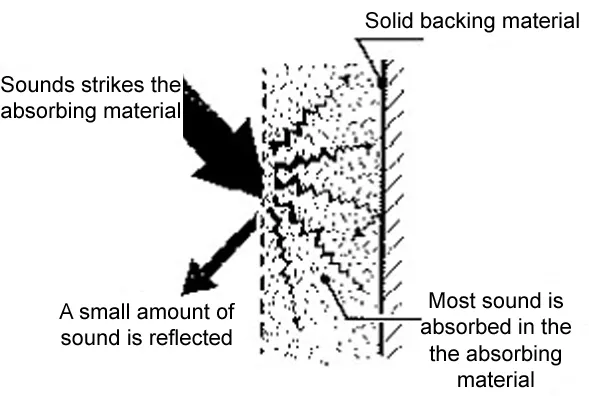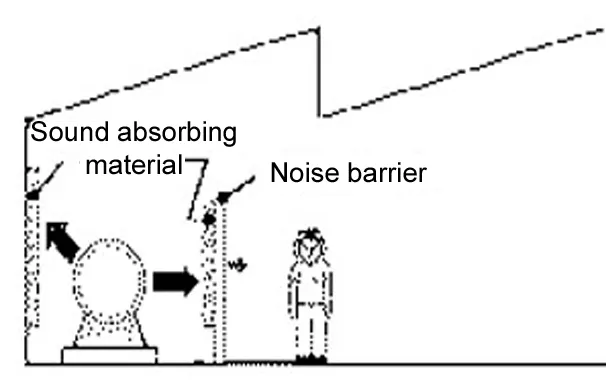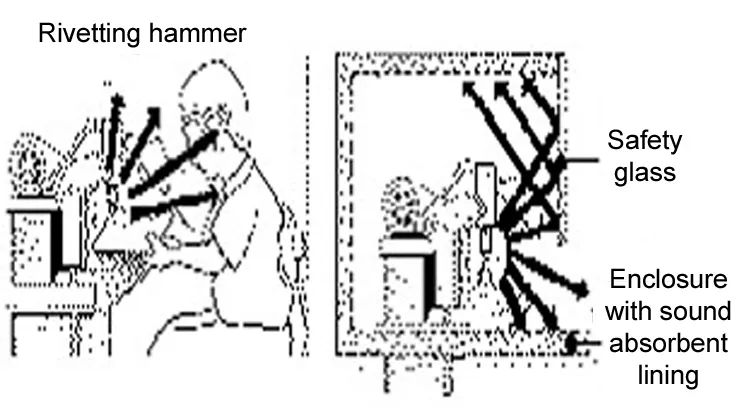If you want to know about the acoustics in auditorium or acoustics in cinema or acoustics in landscape, please click the link.
Sound isolation refers to the process of reducing or eliminating the transmission of sound between two spaces. This is typically achieved by creating a physical barrier between the two spaces that can absorb or reflect sound waves, preventing them from passing through.
- Only two things stop sound – mass and space.
- We need mass to contain the airborne sound, but then we also need space (an air gap or similar unobstructed area) so that the structure borne sound cannot be transmitted.
- Sound isolation techniques such as staggered stud walls or resilient channels work on those principles, there is a high mass wall, an air gap, and then another wall, making sound transmission difficult.
Isolation of a room is done by
- Soundproofing the room.
- Preventing the entrance of sound from the outside is accomplished by sealing openings
- Making the walls absorbent of sound
- Minimizing the passage of sound energy through the solid structures of the walls.
- Sound absorbing materials such as foam insulation in the walls help with both the sealing and absorbing of mid-range to high frequency sounds, but bass frequencies tend to be efficiently borne through solid structures.
- To isolate a room such as a recording studio from low frequencies, the “room within a room” approach is often taken.
- A double wall structure can greatly reduce bass transmission
2) Sound isolation in performance spaces
i) Performance spaces
There are three basic types of performance spaces:
- Single purpose rooms
- Multipurpose rooms
- Rehearsal rooms
Though these spaces vary widely, they share one fundamental acoustical requirement: silence, the elimination of background noise.
Single-purpose rooms
- The single-purpose performance space is a delight. Spaces with a focused acoustical function, such as concert halls, recital halls and dedicated lecture room.
Properties
- Limit the size, exclude background noise, focus the design around acoustical function, and excellence acoustics comes well within reach.
- In real life, the true single-purpose performance space is rare. Nearly all performance spaces are multi use in practice, if not by design. Even dedicated concert halls are used for a variety of purposes.
Multipurpose rooms
- Multipurpose performance spaces are often built to save the money.
- A school, for instance, that might be better served by a music recital hall and a speech theatre, builds one large, multipurpose auditorium.
- Multipurpose spaces are often too large, with budgets too small to provide what is necessary to make them work.

- The large, multipurpose performance space is one of the most difficult acoustical challenges, even under the best of circumstances
- Churches and synagogues are the most common multipurpose spaces.
Rehearsal rooms
- Rehearsal rooms, unlike most performance spaces, are usually too small. Sometimes, a music group that is too large or too loud will simply overwhelm the space.
- For these rooms, one needs a combination of sound absorption and sound-diffusing geometry that makes the room act like a larger room.
Sound isolation
- Rehearsal rooms are often located near performance spaces or other rehearsal rooms, and so require good sound isolation from these other spaces.
Background noise
- Although background noise may not be as critical in a rehearsal space as in a performance space, mechanical (HVAC) noise control can make all the difference in the acoustics.
Adjustable acoustics
- Relatively uncommon but very helpful is the use of adjustable acoustics for a rehearsal room utilized by different types of ensembles.
- A small vocal ensemble needs a room with some reverberation in order to blend its sound.
- A band, at the other extreme, requires maximum sound absorption.
- If both groups must share the same room, adjustable sound absorption is the means for satisfying both requirements
3) Some solutions for sound isolation of performance spaces
i) Clouds
- Flying sound reflecting “clouds” are a tried and true method for dealing with the acoustics of larger rooms. Flying clouds are the key to the classic problem of clarity within a reverberant space. However, these clouds are visible. To be effective, they must be placed in highly locations, and be sufficiently large to function properly
ii) Room surfaces and reverberation
- Different performance types require different amounts of reverberation, sometimes radically different amounts. Broadly speaking, speech requires less reverberation; music requires more, with organ music requiring the most. This is less of a problem with smaller halls, but becomes critical with larger spaces.
iii) Curtains
- The best solution is adjustable reverberation: curtains. However, curtains are bulky, expensive, and awkward. Furthermore, in order to be effective, tremendous curtain surface area is necessary—more than most people realize. While many rooms where the amount of curtain is not sufficient to make much of an audible difference.
iv) Sound absorbing panels
- Sound-absorbing panels are a very useful product, but like all “acoustical” items, they have to be used appropriately. In multi-purpose performance spaces, it is always better to change the remembrance of the room with adjustable curtains, rather than using static sound absorbing panels.
v) Audience configuration
Balconies are the best way to use geometry to improve acoustics, especially side balconies. Nearly every acoustically excellent concert hall, opera house, and drama theatre (above a certain size) ever built has side balconies. The most successful church designs also have side balconies. These balconies serve important functions:
- They make the space narrower;
- They serve as sound reflectors;
- They provide the best seats.
4) Residential noise control
- Our homes buffer us from the noisy outside world.
- If we live out in the country, noise may be less of a problem (unless we live next door to a farm). Birdsong is a pleasant sound.
- But if we live next door to a fledgling drummer, or an airport, or if we are a concert pianist, then residential noise control is important to us.

- Sound is blocked by solid, massive and airtight barriers.
- The thicker the barrier relative to the wavelength of sound, the better it will block sound.
- Low frequency sounds have longer wavelengths; to a low frequency sound, even a thick wall may be relatively thin.
- We can hear this if we have been in a room with a television next door. We can’t make out individual voices because the wall blocks the high frequency sounds necessary for understanding speech.
6) What acoustic materials do
The materials you use for noise reduction can work in four basic ways
i) Sound isolation
Stopping sound from passing through, by reflecting it.

- Stiff heavy materials will stop a lot of sound, although limp, heavy materials are also good. Common materials include sheet metal, timber, masonry, plasterboard, glass and loaded vinyl.
- These can also be used in double leaf constructions, e.G., Plasterboard on timber studs, doubled glazed windows, in which case the air space needs to be as wide as possible.
- Porous materials, perforated materials or very light materials are poor performers for noise isolation, although they may be good sound absorbers.
ii) Sound absorption
Soaking up sound so it is not reflected.

- Porous materials such as open cell foams and fibrous materials (fiberglass, rock wool) act as very good sound absorbers by converting sound energy to a small amount of heat.
- Note however that most sound absorbing materials are poor performers for noise isolation, as they allow sound to pass through easily.
- Closed-cell foams, e.G. Polystyrene, are poor sound absorbers.
- Sound absorbing materials often need to have a protective facing to prevent damage.
- Common facings include perforated sheet metal (10% open area), perforated foil (isolation), or perforated vinyl.
iii) Acoustic barriers and screens
Noise can be screened by building a noise barrier.

The sound absorbing layer stops sound echoing in the area near the source and bouncing over the barrier. It can be secured at its edges in metal channel sections or with timber studs and given a protective facing (see “sound absorption” above).
Some ideas:
- Make it a mobile screen by adding wheels;
- Add a glass or perspex viewing window; and
- Sound absorbing material on the ceiling above and the wall behind – it will work better.
iv) Acoustic enclosure
Can range in size from a small box or cover to a tractor cab, up to a large machine enclosure or sound proofed room.

Points to watch
- The wall materials need to be heavy enough to isolate the required amount of sound (see “sound isolation” above).
- An absorbing layer on the inside to reduce sound build-up should be used.
- Seal off any gaps or openings by block-off pieces and gunned sealant, or flexible flaps where openings are necessary.
- Make sure any doors, hatches or removable panels have full seals on each contacting edge.
- Make sure the enclosure is not touching any vibrating part of the machine, or it may vibrate as well – isolate any pipe work which penetrates the enclosure, sealing the gap with soft sealant.
- Don’t forget that the machine may need ventilation – provide silenced airflow ductwork
v) Vibration isolation
Stopping vibration energy passing from one point to another.

Situations where vibration isolation may be needed
- A vibrating machine rigidly mounted on a floor above ground.
- Pipe work (from a vibrating machine) rigidly fixed to a wall or ceiling.
- Part of a machine touching or connected to a large panel which can vibrate (and radiate noise), e.g., A ceiling-mounted air conditioner touching the ceiling grid
- Materials which are “springy” can be used to isolate a vibrating machine from a floor, wall, or ceiling. These can take the form of springs, rubber mounts, air cushions, pads or mats of rubber, cork or fiberglass. Selection of the best isolator for a job is a specialized task.
- Springy materials are also very good as buffers for absorbing impacts.
- Example: put the tip of your finger on a wine glass and tap the glass. It should ring. Now tap your finger. What happens? Why?
8) In summary
- Your skills can be used to reduce noise in the workplace.
- Having a basic knowledge of acoustic materials and how they work and knowing some of the pitfalls in “building quiet” will help.
- For further assistance, you can look up any good text on architectural acoustics, and the following web sites.
Overall, sound isolation is an important consideration in many different contexts, and can have a significant impact on the quality of life in both residential and commercial settings.